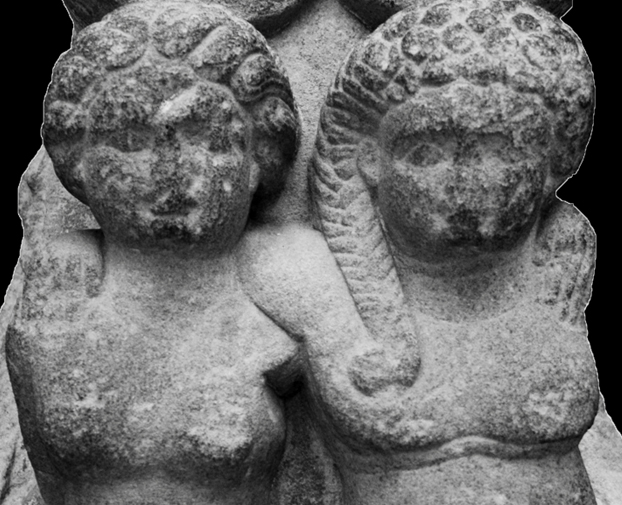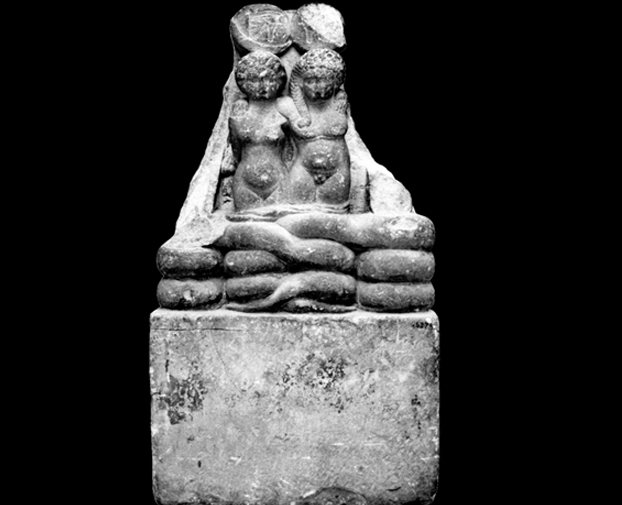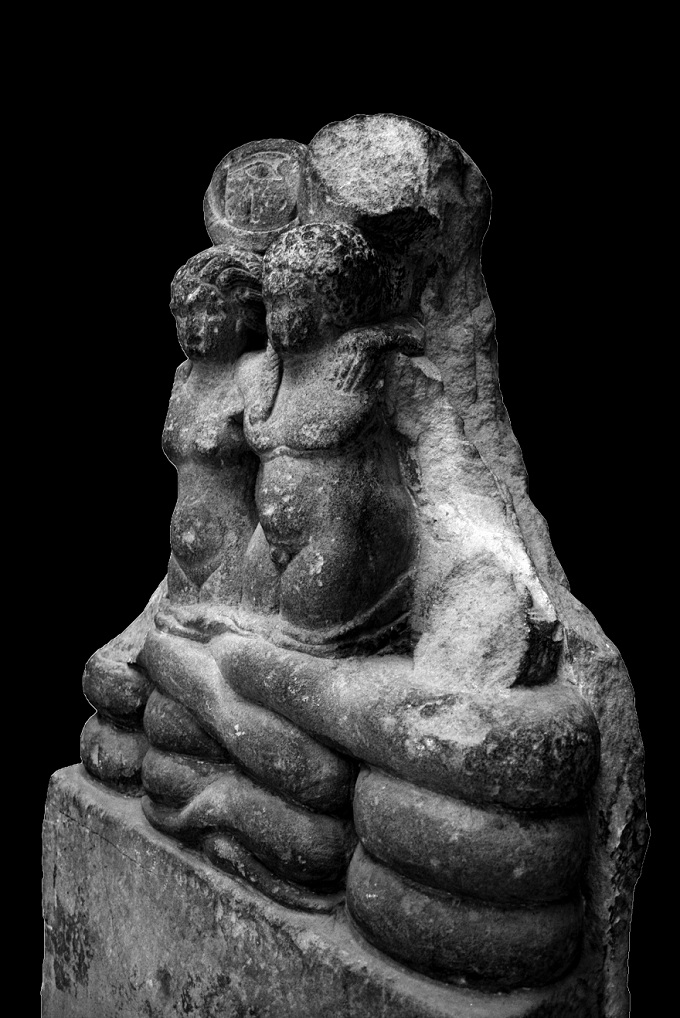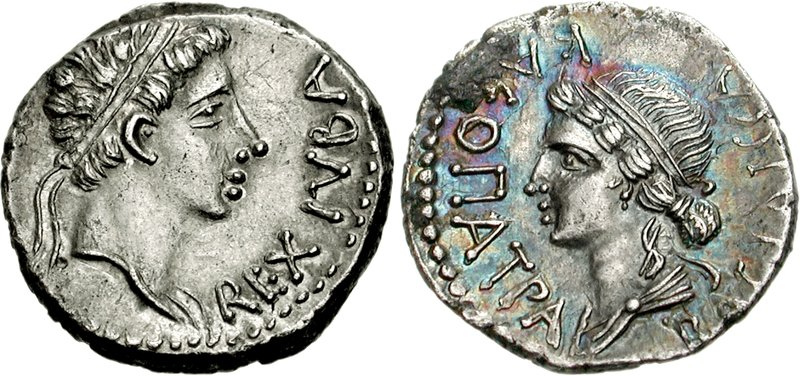It looks like you're using an Ad Blocker.
Please white-list or disable AboveTopSecret.com in your ad-blocking tool.
Thank you.
Some features of ATS will be disabled while you continue to use an ad-blocker.
10
share:
To start, I used the search function and didn't see this anywhere and mods if this is in the wrong forum please feel free to move it to the
appropriate one.
Cleopatra and Antony's Children Rediscovered




Main Source
Second Source
Third Source
Cleopatra and Antony's Children Rediscovered

Cleopatra's twin babies now have a face. An Italian Egyptologist has rediscovered a sculpture of Alexander Helios and Cleopatra Selene, the offspring of Mark Antony and Cleopatra VII, at the Egyptian museum in Cairo.
Discovered in 1918 near the temple of Dendera on the west bank of the Nile, the sandstone statue was acquired by the Egyptian Museum in Cairo but has remained largely overlooked.
The back of the the 33-foot sculpture, catalogued as JE 46278 at the Egyptian museum, features some engraved stars -- likely indicating that the stone was originally part of a ceiling. Overall, the rest of the statue appears to be quite unusual.
"It shows two naked children, one male and one female, of identical size standing within the coils of two snakes. Each figure has an arm over the other’s shoulder, while the other hand grasps a serpent," Giuseppina Capriotti, an Egyptologist at the Italy's National Research Council, told Discovery News.
The researcher identified the children as Alexander Helios and Cleopatra Selene, Antony and Cleopatra's twins, following a detailed stylistic and iconographic analysis published by the Polish Centre of Mediterranean Archaeology at the University of Warsaw.
Capriotti noticed that the boy has a sun-disc on his head, while the girl boasts a crescent and a lunar disc. The serpents, perhaps two cobras, would also be different forms of sun and moon, she said. Both discs are decorated with the udjat-eye, also called the eye of Horus, a common symbol in Egyptian art.
"Unfortunately the faces are not well preserved, but we can see that the boy has curly hair and a braid on the right side of the head, typical of Egyptian children. The girl’s hair is arranged in a way similar to the so-called melonenfrisur (melon coiffure ) an elaborated hairstyle often associated with the Ptolemaic dynasty, and Cleopatra particularly," said Capriotti.
The researcher compared the group statue with another Ptolemaic sculpture, the statue of Pakhom, governor of Dendera, now on display at the Detroit Institute of Arts, USA.

"Stylistically, the statues have several features in common. For example, the figures have round faces, little chins and big eyes," Capriotti said.
Since the statue of Pakhom was dated to 50-30 B.C., she concluded that the twin sculpture was produced by an Egyptian artist at the end of the Ptolemaic period, after Roman triumvir Mark Antony recognized his twins in 37 B.C.
The babies weren't the firsts for Cleopatra. The Queen of Egypt had already given birth in 47 B.C., when she bore Julius Caesar a child, Caesarion. In 36 B.C. she presented Antony with another son, Ptolemy Philadelphus.
At the time of their birth in 40 B.C., the twins were simply named Cleopatra and Alexander. When they were officially recognized by their father three years later, as Antony returned to Antioch, in present Turkey, and Cleopatra joined him, they were named Alexander Helios (Sun), and Cleopatra Selene (Moon).
"Antony's recognition of the children was marked by an eclipsys. Probably for this reason, and to mythologize their twin birth, the children were added those celestial names. Although in Egypt the moon was a male deity, in the sculpture the genders were reversed according to the Greek tradition," Capriotti said.

Little is known of the children Cleopatra and Mark Antony left behind after their suicides in 30 B.C. following defeat in battle.
While Caesarion was murdered under Octavian's orders, the lives of the three offsprings of Cleopatra and Antony were spared.
Cleopatra Selene and Alexander Helios, then aged 10, and Ptolemy Philadelphus, then aged four, were moved to Rome and put under the care of Octavian's sister, Octavia whom Antony was married to.
Some years later, Alexander Helios and Ptolemy Philadelphus would disappear without a trace.
Only Cleopatra Selene survived. Married to King Juba II of Mauretania, she had at least one child, Ptolemy Philadelphus, likely named in honor of her little brother.
Her image was minted on coins along with Juba's, suggesting that she ruled as an equal partner.

"Now we have her portrayed as a child with her twin brother. Blending Egyptian myths and Greek culture, this sculpture fully represents Egypt at Cleopatra's time," Capriotti said.
Main Source
Second Source
Third Source
edit on 21-4-2012 by Ericthenewbie because: (no reason given)
Originally posted by Ericthenewbie
for the op...that art looks Greek, not Egyptian....as greco-romans, cleopatra was influenced by the mediteranean and not egypt....mixing humans and snakes in art was greek...
ok now,
cleopatra and anthony surrendered egypt to the romans....
under them....Egypts Pharonic line fell....and Rome went from a Republic to an Empire....
the slut tried to sleep with half the mediteranean trying to form an alliance.....
an embarresmnent to the nedjai that protected her
her "foriegn" children were not accepted by egyptains, her army (nedjai) aparantly killed ceasarian her child with ceaser
this woman never went into upper egypt, she didnt see karnack , abyods, thebes.....ffs i have!
there was probably a dual lineage.....
ps...anyone who thinks she died from a snake bite...is an idiot...after surrendering egypt to her medteranean masters, she most likely returned to macedonia and lived a fruitful life.
and anyone who thinks mark anthony didnt sabotage Egypt for Rome is a double idiot...
sorry for the rant, i hate these two and their BS legacy...pure emperial lies
peace
edit on 21-4-2012 by thePharaoh because: (no reason given)
reply to post by thePharaoh
Thanks for the contribution. I'm intrigued to find out more on your perspective, where should I be looking to expand my exposure to your perspective?
Thanks for the contribution. I'm intrigued to find out more on your perspective, where should I be looking to expand my exposure to your perspective?
Originally posted by Ericthenewbie
reply to post by thePharaoh
Thanks for the contribution. I'm intrigued to find out more on your perspective, where should I be looking to expand my exposure to your perspective?
this is the percpective of upper egypt....since the fall of taharqo to the persians...the north became very foreign.
alexander the great....cleopatras ancestor.....liberated north egypt from the persians (he also didnt venture into upper egypt)....and since then the ptolemys, as honourary pharaohs, egypts north was ruled by this greco-roman line....actually macedonian.
now Cleopatra, from Alexandria, was desperate to form alliances with rome.....i mean her army was more than capable in defending itself....why would she let anthony, a disrespectful roman general "lead" her army against rome...
to add, that was the first and only time the egyptian army lost to Rome.....then started 600 years of real oppression in upper egypt by the romans
so thanks cleo....
also have you seen the cleopatra movie with elizibeth taylor....when mark anothony was on one of the head ships in the egyptian fleet....somehow...a small boat with 6 romans pulls up next to it....and take anthony, and he was trying to fight them as to stay on the egyptian ship.....hahahahhaaa....closer to the truth would be,,,,,the dude dived into the water and swam for a roman ship
ps...no pharaoh ever ...i mean ever,,,,,commited suicide.....
the term "snake bite" probably carrys connotations.....
peace
edit on 21-4-2012 by thePharaoh because: (no reason given)
Ah the historical Christ finally surfaces on ATS,Helios (Christ) Sun-Son, Salene (Magdalene) Moon.Octavian's wife was Mother Mary.Not the birth
mother,there are two women's stories being told in the new testiment.Both stories are merged as one.
Helios(Christ) was paraded down the street's of Rome (not Israel) and crucified.Hence all records of him ended.
Life is stranger than fiction.
Helios(Christ) was paraded down the street's of Rome (not Israel) and crucified.Hence all records of him ended.
Life is stranger than fiction.
Originally posted by 13th Zodiac
Ah the historical Christ finally surfaces on ATS,Helios (Christ) Sun-Son, Salene (Magdalene) Moon.Octavian's wife was Mother Mary.Not the birth mother,there are two women's stories being told in the new testiment.Both stories are merged as one.
Helios(Christ) was paraded down the street's of Rome (not Israel) and crucified.Hence all records of him ended.
Life is stranger than fiction.
oh yea....
0 - 32 BC.....
EGYPT FELL
BIRTH OF ROMAN EMPIRE
AND IT WAS ALL IN.....JESUS `S LIFETIME!!!
deep ass 32 years
peace
reply to post by thePharaoh
I would really like to expand my understanding of your perspective but I'll need a lot more then just a Hollywood movie starring Elizabeth Taylor...can you provide me with some source material that I can begin to research your understanding on my own to determine for myself the validity of your claims? To be clear, I'm not saying you are wrong but I would like to investigate it and make my own conclusion on the matter...hopefully at the very least, you can point me in the right direction aside from a movie.
I would really like to expand my understanding of your perspective but I'll need a lot more then just a Hollywood movie starring Elizabeth Taylor...can you provide me with some source material that I can begin to research your understanding on my own to determine for myself the validity of your claims? To be clear, I'm not saying you are wrong but I would like to investigate it and make my own conclusion on the matter...hopefully at the very least, you can point me in the right direction aside from a movie.
reply to post by Ericthenewbie
oh, you`ll have to meet puff, the magic dragon........
lol
peace
I would really like to expand my understanding of your perspective
oh, you`ll have to meet puff, the magic dragon........
lol
peace
edit on 21-4-2012 by thePharaoh because: MY ASS ITCHED
reply to post by thePharaoh
Maybe it would help if I clarified the main parts that I don't properly understand of your perspective;
I'm not sure how (based on the information I have read) that they "surrendered Egypt to the Romans"...
There is another school of thought that Octavian (later known as Augustus) could have killed her but nothing I have found indicates she lived a fruitful life in Macedonia.
Anthony and Cleopatra may have indeed been the first Pharaohs to kill themselves based on the same fact that you said they sabotaged/surrendered Egypt for the Romans;
How did her army kill Caesarion? Was it under the order of Octavian/Augustus?
Maybe I'm.. as you said an "idiot/double idiot"...but you haven't provided any sources that say my understanding is incorrect aside from the perspective you provide in your posts.
Off-Site Content
Maybe it would help if I clarified the main parts that I don't properly understand of your perspective;
cleopatra and anthony surrendered egypt to the romans....
her army (nedjai) aparantly killed ceasarian her child with ceaser
ps...anyone who thinks she died from a snake bite...is an idiot...after surrendering egypt to her medteranean masters, she most likely returned to macedonia and lived a fruitful life. and anyone who thinks mark anthony didnt sabotage Egypt for Rome is a double idiot...
the term "snake bite" probably carrys connotations
I'm not sure how (based on the information I have read) that they "surrendered Egypt to the Romans"...
After losing the Battle of Actium to Octavian's forces, Antony committed suicide. Cleopatra followed suit, according to tradition killing herself by means of an asp bite on August 12, 30 BC......The ancient sources, particularly the Roman ones, are in general agreement that Cleopatra killed herself by inducing an Egyptian cobra to bite her. The oldest source is Strabo, who was alive at the time of the event, and might even have been in Alexandria. He says that there are two stories: that she applied a toxic ointment, or that she was bitten by an asp on her breast. Several Roman poets, writing within ten years of the event, all mention bites by two asps, as does Florus, a historian, some 150 years later. Velleius, sixty years after the event, also refers to an asp
There is another school of thought that Octavian (later known as Augustus) could have killed her but nothing I have found indicates she lived a fruitful life in Macedonia.
Anthony and Cleopatra may have indeed been the first Pharaohs to kill themselves based on the same fact that you said they sabotaged/surrendered Egypt for the Romans;
that was the first and only time the egyptian army lost to Rome
How did her army kill Caesarion? Was it under the order of Octavian/Augustus?
She was briefly outlived by Caesarion, who was declared pharaoh by his supporters, but he was soon killed on Octavian's orders.
Maybe I'm.. as you said an "idiot/double idiot"...but you haven't provided any sources that say my understanding is incorrect aside from the perspective you provide in your posts.
Off-Site Content
reply to post by thePharaoh
I was really hoping that now you are back at ATS...any chance you could respond to my last post? I'm still curious,lol.
I was really hoping that now you are back at ATS...any chance you could respond to my last post? I'm still curious,lol.
Originally posted by Ericthenewbie
reply to post by thePharaoh
Maybe it would help if I clarified the main parts that I don't properly understand of your perspective;
cleopatra and anthony surrendered egypt to the romans....
her army (nedjai) aparantly killed ceasarian her child with ceaser
ps...anyone who thinks she died from a snake bite...is an idiot...after surrendering egypt to her medteranean masters, she most likely returned to macedonia and lived a fruitful life. and anyone who thinks mark anthony didnt sabotage Egypt for Rome is a double idiot...
the term "snake bite" probably carrys connotations
I'm not sure how (based on the information I have read) that they "surrendered Egypt to the Romans"...
After losing the Battle of Actium to Octavian's forces, Antony committed suicide. Cleopatra followed suit, according to tradition killing herself by means of an asp bite on August 12, 30 BC......The ancient sources, particularly the Roman ones, are in general agreement that Cleopatra killed herself by inducing an Egyptian cobra to bite her. The oldest source is Strabo, who was alive at the time of the event, and might even have been in Alexandria. He says that there are two stories: that she applied a toxic ointment, or that she was bitten by an asp on her breast. Several Roman poets, writing within ten years of the event, all mention bites by two asps, as does Florus, a historian, some 150 years later. Velleius, sixty years after the event, also refers to an asp
There is another school of thought that Octavian (later known as Augustus) could have killed her but nothing I have found indicates she lived a fruitful life in Macedonia.
Anthony and Cleopatra may have indeed been the first Pharaohs to kill themselves based on the same fact that you said they sabotaged/surrendered Egypt for the Romans;
that was the first and only time the egyptian army lost to Rome
How did her army kill Caesarion? Was it under the order of Octavian/Augustus?
She was briefly outlived by Caesarion, who was declared pharaoh by his supporters, but he was soon killed on Octavian's orders.
Maybe I'm.. as you said an "idiot/double idiot"...but you haven't provided any sources that say my understanding is incorrect aside from the perspective you provide in your posts.
Off-Site Content
edit on 20-7-2012 by Ericthenewbie because: (no reason
given)
reply to post by Ericthenewbie
hey dude...yea cool
ok cleopatra...like the ptolomys just before her......had issues with the core of egypt...ie karnack, thebes, memphis and helipolis.
all of the provinces of upper egypt, the soutrh wher eit matterd....had their own lineage....cleopatra never went into the south as she didnt represent them.
alexander...the first greek pharaoh....was INVITED into egypt to help defeat the persians.
only on alexanders return could he then enter egypt through the south, backed by the entire worlds army.
but as we know he died
what kind of niave person would think that anyone would war with her people, ancestors, family and her bloodline...if we were to believe that cleopatra was fighting the mediteranean ie greece and rome...on behalf of egypt....a place she couldnt go.....
thats is ifyou consider alexandria to be what it was..a fortified mediteranaen port.....a port for romans and greeks to enter egypt.
hostory state that...somehow...antony was on the lead ship in the fleet...during a naval battle...a tiny boat...with his soldiers (ie he was a general i think) managed to pluck him off this boat...
why would cleopatra let a roman general outrank her nedjai, when for 3000 yrs the nedjai were unbeaten....well in the end the egyptians lost....
rome plundered Egypt and the roman republic became an empire.
to beleieve this macedonian (same family of achilles in the film troy)...killed herslf andso did anthony....is naavety...she allowed them to lose a fight by letting a roman general lead the war...against rome!
today...this wouldnt stand up in court...too many holes.....
after turning rome into an empire...its only a short boat ride to greece....
i bet they never find her body in egypt....ill bet my house.....
peace
oh yea...as for ceasarian....as egypts maitrachy led to many foriegn rulers...in no way were the preists of egypt allow her to create an heir with the enemy...it happened too many times before
hey dude...yea cool
ok cleopatra...like the ptolomys just before her......had issues with the core of egypt...ie karnack, thebes, memphis and helipolis.
all of the provinces of upper egypt, the soutrh wher eit matterd....had their own lineage....cleopatra never went into the south as she didnt represent them.
alexander...the first greek pharaoh....was INVITED into egypt to help defeat the persians.
only on alexanders return could he then enter egypt through the south, backed by the entire worlds army.
but as we know he died
what kind of niave person would think that anyone would war with her people, ancestors, family and her bloodline...if we were to believe that cleopatra was fighting the mediteranean ie greece and rome...on behalf of egypt....a place she couldnt go.....
thats is ifyou consider alexandria to be what it was..a fortified mediteranaen port.....a port for romans and greeks to enter egypt.
hostory state that...somehow...antony was on the lead ship in the fleet...during a naval battle...a tiny boat...with his soldiers (ie he was a general i think) managed to pluck him off this boat...
why would cleopatra let a roman general outrank her nedjai, when for 3000 yrs the nedjai were unbeaten....well in the end the egyptians lost....
rome plundered Egypt and the roman republic became an empire.
to beleieve this macedonian (same family of achilles in the film troy)...killed herslf andso did anthony....is naavety...she allowed them to lose a fight by letting a roman general lead the war...against rome!
today...this wouldnt stand up in court...too many holes.....
after turning rome into an empire...its only a short boat ride to greece....
i bet they never find her body in egypt....ill bet my house.....
peace
oh yea...as for ceasarian....as egypts maitrachy led to many foriegn rulers...in no way were the preists of egypt allow her to create an heir with the enemy...it happened too many times before
edit on 20-7-2012 by thePharaoh because: (no reason given)
edit on 20-7-2012 by
thePharaoh because: (no reason given)
new topics
-
Watts home paranormal activity
Paranormal Studies: 3 hours ago -
So, what is really going on in South Korea ?
World War Three: 3 hours ago -
Congress Says the FBI is Covering Up Vital Info on the Jan 5th 2021 D.C. Pipe Bombs at RNC-DNC.
Political Conspiracies: 4 hours ago -
The trial on kids was stopped
Medical Issues & Conspiracies: 7 hours ago -
Orbs Appear And Form Triangle On Live Cam.
Aliens and UFOs: 8 hours ago -
Biden Has New Bizarre Injuries to His Face
Politicians & People: 10 hours ago -
Something is not adding up in regards to the H-1B commotion
General Conspiracies: 10 hours ago -
Elon Musk Calls for Tommy Robinson to be Freed - and Takes a Dig at Starmer
Politicians & People: 11 hours ago -
Biden to award Presidential Citizens Medal to Liz Cheney and Bennie Thompson
US Political Madness: 11 hours ago
top topics
-
Biden to award Presidential Citizens Medal to Liz Cheney and Bennie Thompson
US Political Madness: 11 hours ago, 11 flags -
Biden Has New Bizarre Injuries to His Face
Politicians & People: 10 hours ago, 11 flags -
Congress Says the FBI is Covering Up Vital Info on the Jan 5th 2021 D.C. Pipe Bombs at RNC-DNC.
Political Conspiracies: 4 hours ago, 9 flags -
The trial on kids was stopped
Medical Issues & Conspiracies: 7 hours ago, 9 flags -
Just learned a really helpful trick for internet searches
Computer Help: 17 hours ago, 7 flags -
Orbs Appear And Form Triangle On Live Cam.
Aliens and UFOs: 8 hours ago, 6 flags -
Something is not adding up in regards to the H-1B commotion
General Conspiracies: 10 hours ago, 5 flags -
Elon Musk Calls for Tommy Robinson to be Freed - and Takes a Dig at Starmer
Politicians & People: 11 hours ago, 5 flags -
So, what is really going on in South Korea ?
World War Three: 3 hours ago, 5 flags -
Watts home paranormal activity
Paranormal Studies: 3 hours ago, 3 flags
active topics
-
Ukraine halts transit of Russian gas to Europe after a prewar deal expired
Political Conspiracies • 113 • : FlatBatt -
Tesla Cybertruck Explodes in Front of Trump Hotel in Las Vegas
Mainstream News • 135 • : Imhere -
Congress Says the FBI is Covering Up Vital Info on the Jan 5th 2021 D.C. Pipe Bombs at RNC-DNC.
Political Conspiracies • 19 • : WeMustCare -
Biden to award Presidential Citizens Medal to Liz Cheney and Bennie Thompson
US Political Madness • 14 • : WeMustCare -
So, what is really going on in South Korea ?
World War Three • 6 • : CriticalStinker -
-@TH3WH17ERABB17- -Q- ---TIME TO SHOW THE WORLD--- -Part- --44--
Dissecting Disinformation • 3903 • : duncanagain -
The C.D.C. Says There Was NO INFLUENZA Worth Reporting for the 2020-2021 Flu Season.
Diseases and Pandemics • 98 • : WeMustCare -
Strange fog all over the northern hemisphere
General Conspiracies • 45 • : TheMisguidedAngel -
The trial on kids was stopped
Medical Issues & Conspiracies • 8 • : fos613 -
Mood Music Part VI
Music • 3775 • : Skinnerbot
10
